More Apartments: Welcome to Thessaloniki...
 A city of diverse beauty and hospitable people. Thessaloniki has always been a crossroad of civilizations, a place where the East and West meets, where great cultures and religions have been mixed. Gastronomy, events, world-class heritage sites and shopping are some of the things that visitors can indulge in.
A city of diverse beauty and hospitable people. Thessaloniki has always been a crossroad of civilizations, a place where the East and West meets, where great cultures and religions have been mixed. Gastronomy, events, world-class heritage sites and shopping are some of the things that visitors can indulge in.
Start your day the “Greek way” with a famous Bougatsa or one Koulouri accompanied by an ice cold Frappe.
The compact size of the city and the walking distance proximity of the top-attractions make Thessaloniki an ideal city-break destination.
What to see in the Centre of Thessaloniki
The Archaeological museum of Thessaloniki is one of the most beautiful and important museums of the city and is housed in a 1962 edifice. It is located in the center of the city.
Due to the city’s rich Ancient Greek, Roman and Byzantine history the museum hosts a variety of exhibits that will impress every visitor. Beautiful samples of Roman architecture, unique colorful mosaics, sculptures and jewellery from the Greek Classical and Hellenistic period await you there...
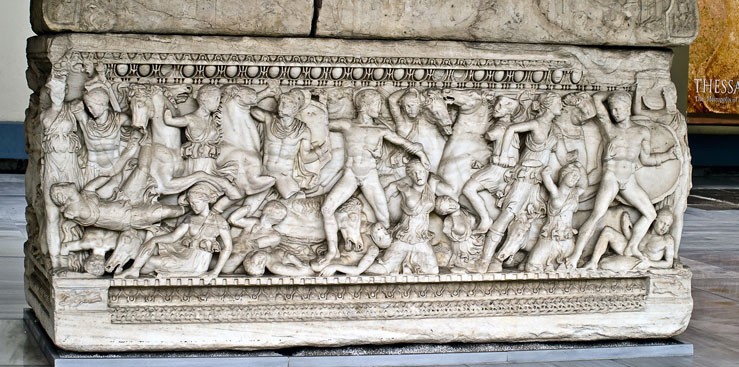 In 2003 the Archaeological Museum of Thessaloniki was completely renovated in order to meet new technical and museological advances. The new exhibition of antiquities was organized into six permanent thematic units that encompass all aspects of personal and public life in antiquity.
The “Gold of the Macedon” and the new permanent open ground exhibition called “Field House Garden Grave” are definitely some of the most interesting areas of the museum. In the South side of the museum there is a cafe available for all the visitors.
For more information:
Archaeological Museum of Thessaloniki
6 Manoli Andronikou Street,
PO Box 506 19
Postal Code 540 13, Thessaloniki, Greece
tel. +30 2313 310201
fax. +30 2310 861306
info.amth@culture.gr
www.amth.gr
In 2003 the Archaeological Museum of Thessaloniki was completely renovated in order to meet new technical and museological advances. The new exhibition of antiquities was organized into six permanent thematic units that encompass all aspects of personal and public life in antiquity.
The “Gold of the Macedon” and the new permanent open ground exhibition called “Field House Garden Grave” are definitely some of the most interesting areas of the museum. In the South side of the museum there is a cafe available for all the visitors.
For more information:
Archaeological Museum of Thessaloniki
6 Manoli Andronikou Street,
PO Box 506 19
Postal Code 540 13, Thessaloniki, Greece
tel. +30 2313 310201
fax. +30 2310 861306
info.amth@culture.gr
www.amth.gr
Museum of Byzantine Culture
The museum of Byzantine Culture is considered as one of the most important museums of Thessaloniki.
The museum is housed in modern facilities. Many unique exhibits and artifacts throughout the entire Byzantine period are displayed in several different rooms.
It is divided in several different thematic sections and collections that cover a wide time period of the city's Byzantine past. Wonderful mosaics and wall paintings, Byzantine icons and religious architecture, impressive jewellery, rare books and scripts await you there.
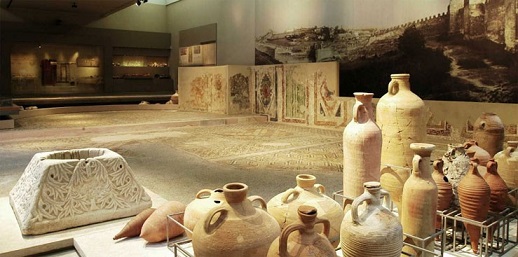 The Museum of Byzantine Culture was awarded the Council of Europe Museum Prize for 2005, following the concurrent recommendation of the Council’ s Committee for Culture, Science and Education.
Museum of Byzantine Culture
2 Stratou Avenue, Thessaloniki 546 40, Greece
P.O.B. 50047, Postcode: 54013 Thessaloniki
Tel:. +30 2313 306 400
Fax: +30 2313 306 402
www.mbp.gr
The Museum of Byzantine Culture was awarded the Council of Europe Museum Prize for 2005, following the concurrent recommendation of the Council’ s Committee for Culture, Science and Education.
Museum of Byzantine Culture
2 Stratou Avenue, Thessaloniki 546 40, Greece
P.O.B. 50047, Postcode: 54013 Thessaloniki
Tel:. +30 2313 306 400
Fax: +30 2313 306 402
www.mbp.gr
Start with Aristotelous Square, the city’s most central square boasting monumental mansions. The Ebrar Committee designed it after the devastating fire of 1917. It is one of the biggest and most impressive squares in Greece offering a fantastic view of Thermaikos Gulf. Under clear skies, you can see the Olympus massif in the far distance from the square.
Walking down Nikis Avenue across the seafront, extending from the city’s Port up to the Statue of Alexander the Great, you will find one of the most popular promenade areas for locals and visitors, lined with many cafés, bars and stores.
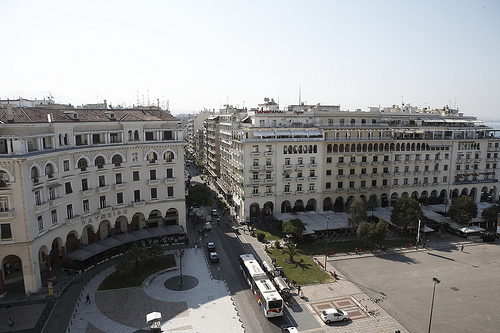
Photography: Giorgos Vitsaropoulos
The city’s landmark is the White Tower (Lefkós Pýrgos). The 33.9 m. high fortified cylinder tower measuring 22.7 m. in diameter was built under Suleiman I the Magnificent in the 16th century. It was part of the city’s fortification and was later used by the Turks as a place of execution (it was called Kanli Kasteli which means "tower of blood"). It goes by its current name since the 19th century. Inside the Tower, there is an exhibition on Thessaloniki’s history, from its establishment until 1922.
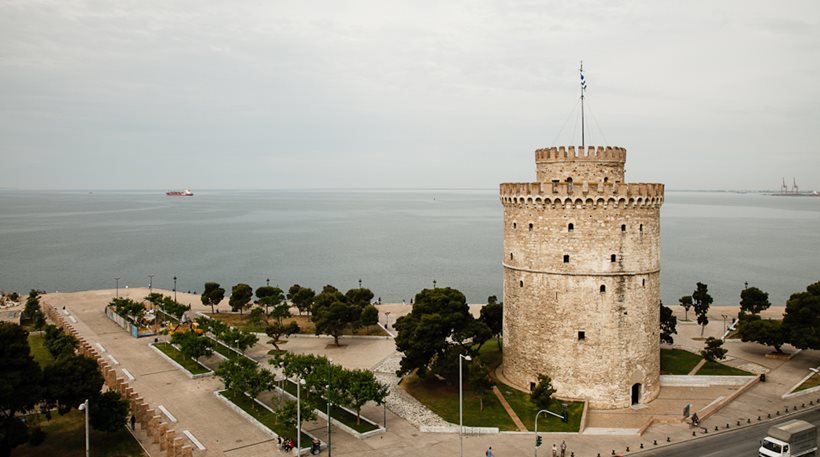
Galerius Palace
Similar as many other famous Romans (Julius Caesar and Pompey, Brutus, the Emperors Anthony and Octavius etc.), who had stayed in Thessaloniki, Galerius Valerius Maximianus, one of the four co-emperors of the Tetrach of the Roman Empire at the end of the 3rd century and in the beginning of the 4th (297-307), had chosen Thessaloniki as his seat.
Galerius decided to adorn the city, in a true Roman way, with imposing buildings and structures. As a result, along with the Eastern Walls of the city, he created a large palace complex – Galerius Palace – consisting of huge buildings, the palace, the octagon, the Rotunda, a large Hippodrome, arcades, triumphal arches etc.
Where Navarinou Square and Demetriou Gounari Street is now located, a significant part of the Galerius Palace complex has been excavated including massive walls, a large internal courtyard, peristyle, corridors and rooms with beautiful mosaic floors, fountains and springs. On the southwest part of the site is where the Octagon lies, a large octagonal structure of almost 30m in internal diameter, which was a temple or the throne room with a wonderful floor paving remaining. The Hippodrome (400m in length), lies on the east of the Palace, unfortunately underneath the block of flats in the Hippodrome Square. Many of its remaining marbles and stones were later used in various repairs to the western walls. On a large marble archway found on the site, which is now placed in the Archaelogical Museum of Thessaloniki, two main figures of the city are represented, the embodiment of Thessaloniki and Galerius himself.
The Arch of Galerius (Kamara)
The Arch of Galerius, better known as the Kamara, is located at the junction of Egnatia and Demetriou Gounari Street further up Navarinou Square. The quadruple arch was part of the large building complex which included the Galerius Palace, the Hippodrome and the Rotunda. It was built at the end of the 3rd century or early 4th to honor the victories of the Emperor Galerius against the Persians in Asia Minor and Syria (297 AD).
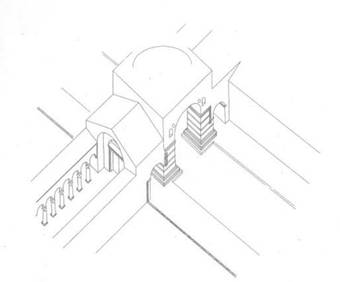 As you can see on the design on the left, four central columns supported a dome and thus created arches. Four gates were formed with two gates on today’s Egnatia Street and the other two on today’s Demetriou Gounari Street, the road that ran from the Galerius Palace up to the Rotunda. Only two of the four columns remain of this impressive structure, the reliefs on which represent the Galerius’ victories against the Persians and the triumphal celebrations. Among others you can see scenes of war, mounted battles and victories, triumphs, ceremonies and sacrifices’ in four bands, separated by relief flowers and branches. Diokletianus, Maximinus and Constantius, the other three of the Roman Tetrach, can be also observed on the relief joined by gods and forms of the Roman tradition.
As you can see on the design on the left, four central columns supported a dome and thus created arches. Four gates were formed with two gates on today’s Egnatia Street and the other two on today’s Demetriou Gounari Street, the road that ran from the Galerius Palace up to the Rotunda. Only two of the four columns remain of this impressive structure, the reliefs on which represent the Galerius’ victories against the Persians and the triumphal celebrations. Among others you can see scenes of war, mounted battles and victories, triumphs, ceremonies and sacrifices’ in four bands, separated by relief flowers and branches. Diokletianus, Maximinus and Constantius, the other three of the Roman Tetrach, can be also observed on the relief joined by gods and forms of the Roman tradition.
The Rotunda
The Rotunda, built in the early 4th century, is an ancient impressive roman monument inscribed in the World Heritage List of Unesco. It was probably first constructed as a mausoleum for the Emperor Galerius, who had his seat at Thessaloniki at the end of the 3rd century and the beginning of the 4th. It was part of the impressive building complex which included the Galerius Palace (Navarinou Square), the Hippodrome, the Arch of Galerius (Kamara) and other buildings in Thessaloniki.
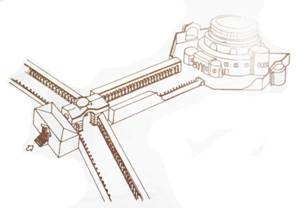 As you can see on the design on the left, there was an impressive street lined with massive colonnades that joined the Arch of Galerius and the rest of the Galerius Palace with Rotunda. The cylindrical building initially had an internal diameter of 24.5m and 30m height, while the walls are 6.3m thick and inside have eight apses (recesses). In the end of the 4th century, the Emperor Theodosius the Great (379-395), was baptised as Christian in Thessaloniki and converted the mausoleum into a Christian church. As a result, the sanctum and perimetric aisle were added and the western gate opened to become the principal entrance instead of the southern.
As you can see on the design on the left, there was an impressive street lined with massive colonnades that joined the Arch of Galerius and the rest of the Galerius Palace with Rotunda. The cylindrical building initially had an internal diameter of 24.5m and 30m height, while the walls are 6.3m thick and inside have eight apses (recesses). In the end of the 4th century, the Emperor Theodosius the Great (379-395), was baptised as Christian in Thessaloniki and converted the mausoleum into a Christian church. As a result, the sanctum and perimetric aisle were added and the western gate opened to become the principal entrance instead of the southern.
The Christians decorated the walls of Rotunda with a mosaic of unbelievable variety of colors, while the figure of Christ was depicted in the center of the cupola in a shining sphere, in the colors of the rainbow. Unfortunately, only little can be seen nowadays of this composition. However, below the cupola, bands of angels, martyrs and the saints of early Christian times are depicted and preserved in a significantly better condition. The church was dedicated to Christ or the Archangels and during the 10th-12th centuries was the cathedral of Thessaloniki.
 During the Turkish occupation, it was turned into a mosque and the minaret, which stands in front of it, was built (1591). After the liberation of the city (1912), the building was re-tranformed into a Cristian church under the name of Saint George (Agios Georios). Finally, the name Rotunda prevailed due to the cylindrical shape of the monument.
During the Turkish occupation, it was turned into a mosque and the minaret, which stands in front of it, was built (1591). After the liberation of the city (1912), the building was re-tranformed into a Cristian church under the name of Saint George (Agios Georios). Finally, the name Rotunda prevailed due to the cylindrical shape of the monument.
The Rotunda is open daily 08.30-15.00
Navarino Square & Agia Sophia (Holy Wisdom)
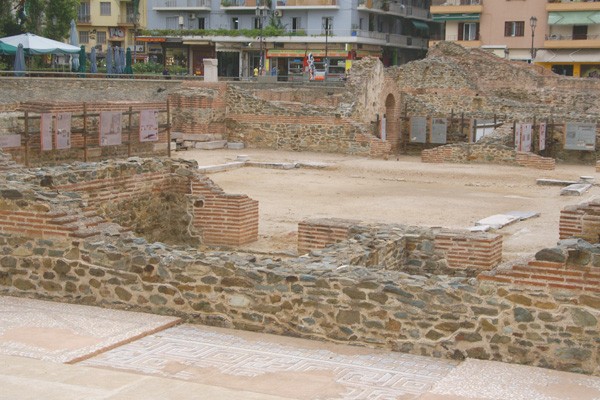 Navarino square is not only the most vibrant area of the city, but also one of the most historic districts within Thessaloniki. Starting this route from the Rotunda, built in the early 4th century, scroll down to the Arch of Galerius which was built at the end of the 3rd century or early 4th to honor the victories of the Emperor Galerius against the Persians. Nowadays, Arch of Galerius or Kamara as it is referred to by thousands of people, is the number one date point of the city and mainly among young people. Further southern and towards the sea, you will come across with the ruins of Galerius Palace, a large palace complex consisted of huge buildings, the palace, the octagon, the Rotunda, a large Hippodrome, arcades, triumphal arches etc., built by Emperor Galerius in the 4th century. Seize your day in the area and enjoy a coffee or a meal in one of the plenty cafes and restaurants of Navarino square. If you find yourself in the district, don’t miss the chance to taste the crepes from the famous creperies.
Navarino square is not only the most vibrant area of the city, but also one of the most historic districts within Thessaloniki. Starting this route from the Rotunda, built in the early 4th century, scroll down to the Arch of Galerius which was built at the end of the 3rd century or early 4th to honor the victories of the Emperor Galerius against the Persians. Nowadays, Arch of Galerius or Kamara as it is referred to by thousands of people, is the number one date point of the city and mainly among young people. Further southern and towards the sea, you will come across with the ruins of Galerius Palace, a large palace complex consisted of huge buildings, the palace, the octagon, the Rotunda, a large Hippodrome, arcades, triumphal arches etc., built by Emperor Galerius in the 4th century. Seize your day in the area and enjoy a coffee or a meal in one of the plenty cafes and restaurants of Navarino square. If you find yourself in the district, don’t miss the chance to taste the crepes from the famous creperies.
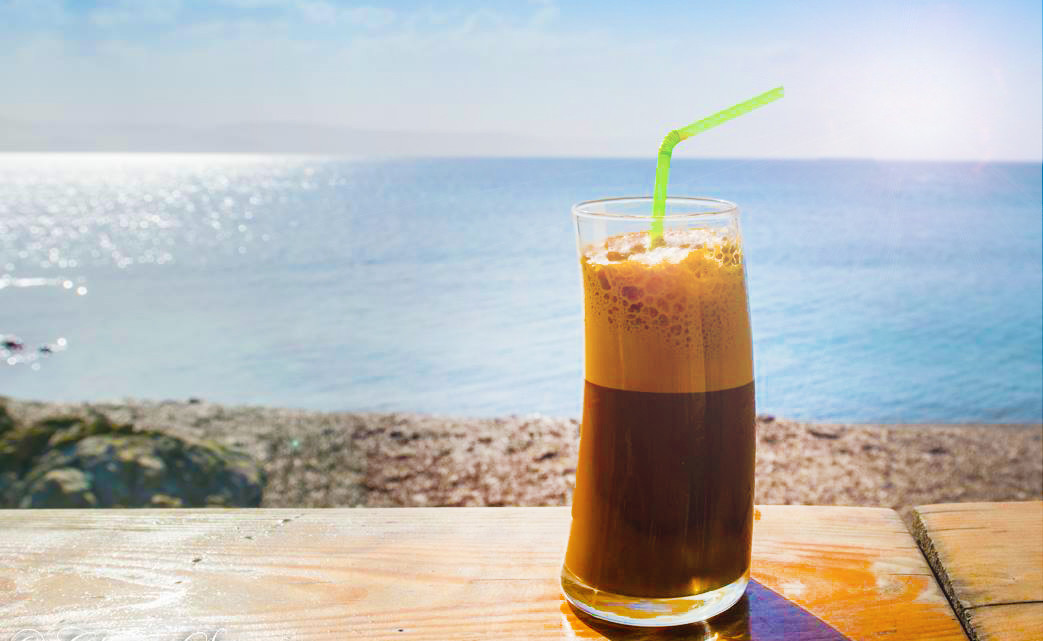 Just a few meters away you will find Zefxidos and Iktinou streets, two of the most crowed pedestrians of the city center, full of cafes and bars. If you follow the route to the sea you will reach Vogatsikoy street with some very interesting dining choices and the city’s Cathedral at the junction with Mitropoleos street. Next to the Cathedral, you can visit the Museum of Macedonian Struggle, which was fully renovated in 2009.
Just a few meters away you will find Zefxidos and Iktinou streets, two of the most crowed pedestrians of the city center, full of cafes and bars. If you follow the route to the sea you will reach Vogatsikoy street with some very interesting dining choices and the city’s Cathedral at the junction with Mitropoleos street. Next to the Cathedral, you can visit the Museum of Macedonian Struggle, which was fully renovated in 2009.
If you then follow Agias Sophias street, it will lead you straight up to the pedestrian, the square and the famous church of the same name. Agia Sophia is one of Thessaloniki’s and Christianity’s monuments and it is inscribed in the World Heritage List of UNESCO. Another paleochristian monument of Thessaloniki, the Church of Acheiropoeitos, can be found just beyond Egnatia street. This church was built in the middle of the 5th century (450-460), probably on the site of an ancient temple of the Thermaia Aphrodite.
Roman Forum & Agios Dimitrios (St. Demetrius)
Straight up Aristotelous square and crossing Egnatia street you will meet Dikastirion square located in one of the most historic areas of Thessaloniki. At the bottom right of the square (heading north) you will find Bey Hamam, an important Ottoman period monument of the city center since it is the biggest Turkish bath in Greece. It was built by the Sultan Mourat II in 1444 just 14 years after conquest of the city. It operated as “Paradeisos Bathhouse” until 1968 and now operates as an exhibition center. On the opposite bottom of the square you will have the opportunity to admire one of the most beautiful churches of Thessaloniki. Panagia Chalkeon is one of Thessaloniki’s jewels, which was built in 1208 on the site of an ancient temple of Hephaestus. Then, as now, this was the area where the coppersmiths had their workshops and hence the name.
Another site worth visiting is the Ancient Agóra (Market place), a trading place from the 3rd century BC until the 5th century AD. Discoveries include the city’s Agora (Market place), the Mint, the Odeion, a hall believed to have been housing the city archives, a part of Valaneio with baths, a tavern and a whore-house, along with many smaller finds. There is an ancient temple and Early Christian tombs (4th -7th century) located under 3rd September Street.
If you continue north and in a quite close walking distance from Ancient Agora you will come across the church of Agios Dimitrios, the patron saint of Thessaloniki. It was first built in the early 4th century (306) as a small house and it suffered two fires (7th century & 1917) before taking its final form. Just beneath the church the very interesting Saint Demetrius Crypt museum contains early Christian sculptures of the 5th, 6th and 7th centuries found in the church, Byzantine sculpture from the church, dated to the 11th-14th centuries, and various excavation finds (coins, pottery), dated to the 5th-14th centuries. Nearby, Agios Dimitrios, it is a good idea to visit Alatza Imaret which was built in 1484, and today the building is used for cultural events and exhibitions.
Before ending this route don’t miss the chance to take a look at Bit Bazaar, a hidden square with many antique shops where you can find great bargains. Moreover, many small taverns and restaurants transform the square in a very vibrant and busy place during the night which is very popular mainly among students and young people.
Port, Ladadika & Food Markets
Dock A of Thessaloniki Port was constructed in the late 19th century. Now, you can find the old warehouses that accommodate the Museum of Photography, the Cinema Museum, the State Museum of Contemporary Art and various cultural activities such as the International Film Festival. The dock was reconstructed during 2011 and it has become an exceptional walking and relaxation area with view of the whole seafront of Thessaloniki.
Eleftherias square, which is just opposite the port, is the starting point of many buses and during the 40’s was the gathering place of many Jews of the city, that’s why you can find there a relative monument. Few meters away you can observe the Stein building and its famous globe on the roof, a structure of 1908 and of the few that survived the fire of 1917.
Make sure to visit Ladádika, the historic neighborhood, close to Aristotelous Square, that was saved from the 1917 fire..
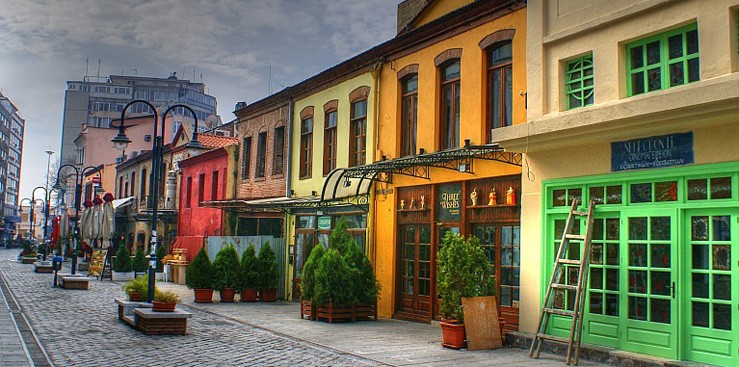 Make sure to visit Ladadika, western of Eleftherias square you will find the Ladadika district, which was the port market with plenty of oil shops (thus the name) and shops that sold spices. The renovated buildings have in the recent years been converted into restaurants and night clubs. However, Ladadika does not only offer dining and drinking opportunities but also two very interesting museums, the Museum of Ancient Greek, Byzantine and Post-Byzantine Instruments and the Jewish Museum. Crossing Egnatia street you will go through the Frankish Quarter or Valaoritou District as it is lately called. The dozens of bars opened here the last years has transformed the neighborhood to the center of Thessaloniki’s nightlife.
Make sure to visit Ladadika, western of Eleftherias square you will find the Ladadika district, which was the port market with plenty of oil shops (thus the name) and shops that sold spices. The renovated buildings have in the recent years been converted into restaurants and night clubs. However, Ladadika does not only offer dining and drinking opportunities but also two very interesting museums, the Museum of Ancient Greek, Byzantine and Post-Byzantine Instruments and the Jewish Museum. Crossing Egnatia street you will go through the Frankish Quarter or Valaoritou District as it is lately called. The dozens of bars opened here the last years has transformed the neighborhood to the center of Thessaloniki’s nightlife.
From the Franskish Quarter, Ermou is the street that will lead you to the famous food markets of Thessaloniki, Modiano and Vlali flea market (or Kapani). Modiano is mainly a meat market with some grocery stores, but also accommodates a few taverns and traditional “fast-food” for hasty visitors of the city center. Just across the street Vlali (or Kapani) market is located which mainly offers fresh fish, spices and milk products. Undoubtedly, shopping in these markets is one of the most unique experiences you can have in Thessaloniki.
The city’s central streets namely Mitropóleos, Tsimiski, Ermoú and Egnatia are lined with shops, awaiting customers. As you are visiting the city centre, notice the elite art nouveau buildings and mansions located there as well as the Holocaust Victims Monument dedicated to the memory of the Greek Jews of Thessaloniki who were exterminated by the Germans during the German Occupation.
Another interesting place to visit is the Byzantine Bath, close to Koule Kafe Square, dating back to the late 13th century, a rare discovery site of Byzantine Baths. There are also mosques worth visiting such as the Ishak Pasha Mosque (1484), situated close to Kassandrou Street and the Hamza Bey Mosque(1467) having been destroyed by an earthquake and rebuilt in 1620. The latter is situated at the junction of Egnatia and Venizelou Streets. Bezesténi is located in the Market centre (Venizelou & Solomou Streets) and used to be the trading place for luxurious textiles. It is a rectangular building with four entrances, built in the late 15th century. The city’s turkish baths include Bey Hamam (1444) on Egnatia Street, Pasha Hamam(1520), Bazaar Hamam and Yeni Hamam. Go for a walk in Kapani and Modiano markets and experience the city’s scents, perfumes and colours.
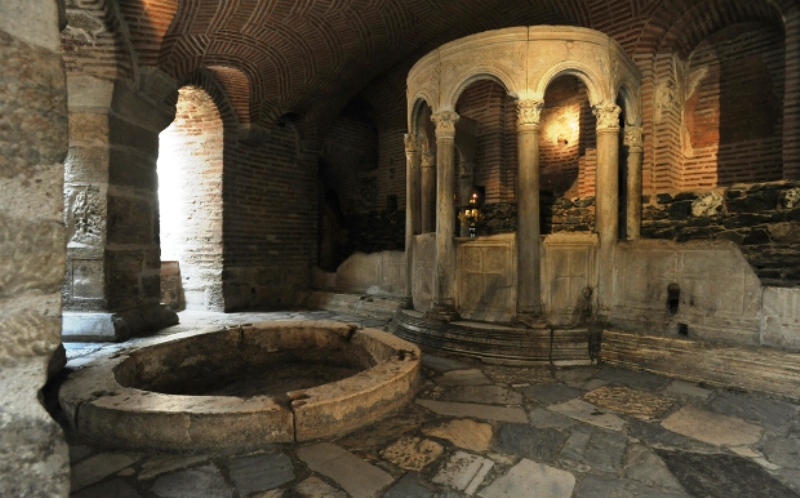
 Take either bus line 28A or 28B from any bus stop on Egnatia street, towards the opposite direction to the city center, and get off at “Astynomia” stop just outside the Western Wall. Enter through the Wall to Ano Poli (Upper Town) at the junction of Evrou and Evrymedontos street. Walk down through the beautiful narrow paved streets where you can admire wonderfully restored old houses such as the National Center of Maps. Further down, where Kleious and Al. Papadopoulou street meet, you will find Tsinari, a famous area with taverns. Tsinari took its name from the homonym tavern, which is the oldest operating tavern in Thessaloniki, opened in 1885 as a Turkish cafe.
Take either bus line 28A or 28B from any bus stop on Egnatia street, towards the opposite direction to the city center, and get off at “Astynomia” stop just outside the Western Wall. Enter through the Wall to Ano Poli (Upper Town) at the junction of Evrou and Evrymedontos street. Walk down through the beautiful narrow paved streets where you can admire wonderfully restored old houses such as the National Center of Maps. Further down, where Kleious and Al. Papadopoulou street meet, you will find Tsinari, a famous area with taverns. Tsinari took its name from the homonym tavern, which is the oldest operating tavern in Thessaloniki, opened in 1885 as a Turkish cafe.
Before descending further down, head up towards the Wall again and visit the “Cultural Neighborhood” of Sykies Municipality. There are houses built by refugees of Asia Minor from 1922 and on. These buildings, that they were built with the city Wall being one of their walls or sometimes even their door, have been restored and now accommodate artistic and cultural workshops in combination with a Refugee Museum and a Youth Center.
If you walk towards the city center, just before leaving Ano Poli, at the homonym street you will find Agia Aikaterini. This church has managed to preserve its external appearance in almost its original form and it is an example of the architecture of the Macedonian School, with a central dome and four smaller domes at the corners.
Following the Western Wall you will eventually reach Agioi Apostoloi (Holy Apostles) Church. At this point, where Letaia Gate used to be, there was a monastery from which only this church of 1314 A.D. survived. Nearby you will find Pasha Hamam (1530 A.D.) that operated until 1981 under the name “Phoenix Bathhouse”. At short distance, at Antigonidon square, an ancient Greek Temple of Venus was recently found here. The biggest part of this temple of the 6th century B.C. is hidden underneath the square; however its detached parts are exposed at the Archaeological Museum of Thessaloniki.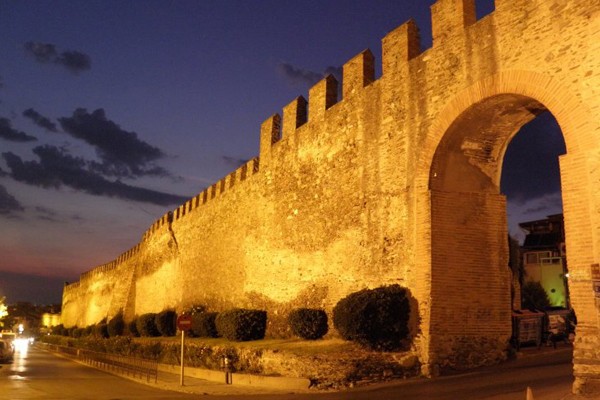 Walking down the Karaoli-Dimitriou ton Kyprion street will lead you to Demokratias square. This was the largest entrance of the ancient city of Thessaloniki, the Golden Gate. Behind the courthouse and at the end of the Western Wall, “Top Hane” is located. “Top Hane”, that formed part of the west fortress, was built by the Ottomans in 1546 A.D. and there can also be found the “Arsenal Tower”, a small octagonal tower. From here began the first artificial port of the city of Thessaloniki that was built by Emperor Constantine the Great during his stay in the city in 322-323 A.D.
Walking down the Karaoli-Dimitriou ton Kyprion street will lead you to Demokratias square. This was the largest entrance of the ancient city of Thessaloniki, the Golden Gate. Behind the courthouse and at the end of the Western Wall, “Top Hane” is located. “Top Hane”, that formed part of the west fortress, was built by the Ottomans in 1546 A.D. and there can also be found the “Arsenal Tower”, a small octagonal tower. From here began the first artificial port of the city of Thessaloniki that was built by Emperor Constantine the Great during his stay in the city in 322-323 A.D.
Do not miss to see the Royal Theatre, a 1940 building, nowadays the seat of the National Theatre of Northern Greece. This three-storey building boasts luxurious halls and in it there is one of the most high-tech stages in Europe. It is located on the White Tower Square. Finish your tour with a coffee on top of the tower of OTE (Hellenic Telecommunications Organization) Tower (1969) located in the premises of the Thessaloniki International Trade Fair and enjoy the fantastic view.